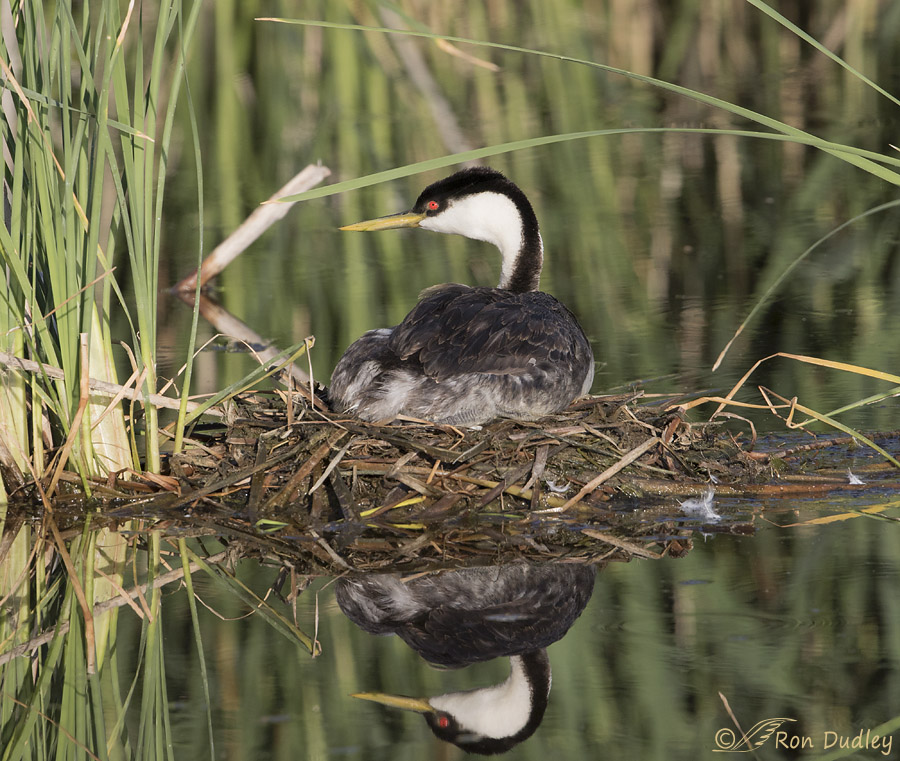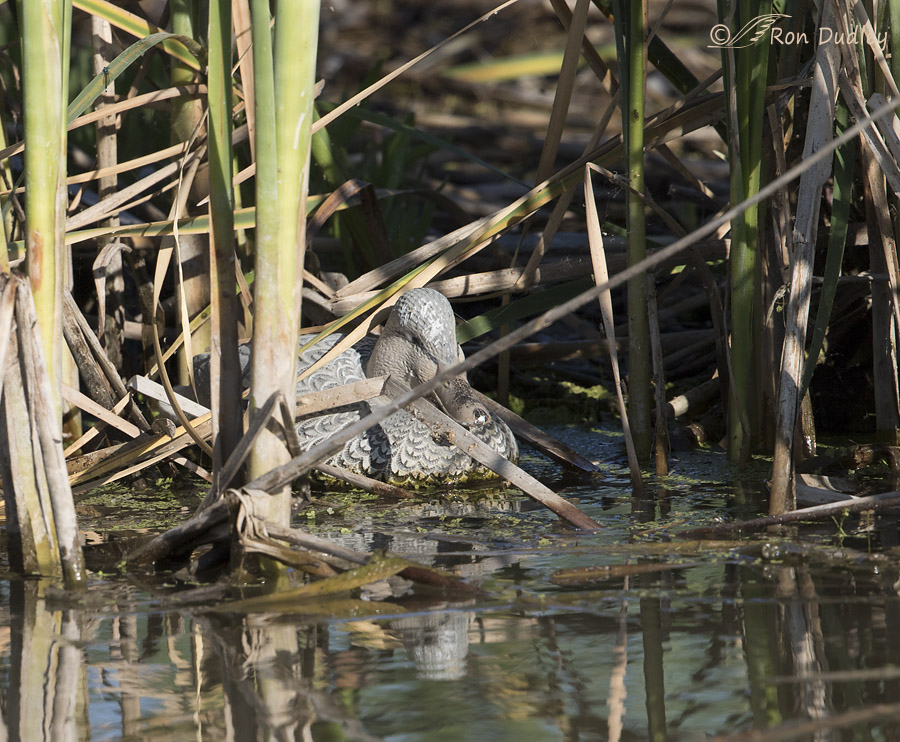I seldom get an opportunity to photograph a grebe of any species on a nest so I’ll take the shot even if the bird has its back to me. At least this Western Grebe gave me a partial head turn in compensation.
 1/1000, f/8, ISO 500, +0 EV, Canon 7D Mark II, Canon EF500mm f/4L IS II USM +1.4 tc, not baited, set up or called in
1/1000, f/8, ISO 500, +0 EV, Canon 7D Mark II, Canon EF500mm f/4L IS II USM +1.4 tc, not baited, set up or called in
I photographed this bird four days ago along the auto tour route at Bear River Migratory Bird Refuge. Both sexes incubate so I don’t know if this is the male or female. The bird was insistent about looking straight ahead so I was able to get only a few shots with its head turned to the side.
For me the nest is at least as interesting as the grebe. Western Grebe nests are typically floating platforms or built up from the bottom and are made from coarse emergent stems and algae or sodden material from the bottom, as seems to be the case here. On average eggs require 24 days to hatch and the chicks leave the nest on their parents backs almost immediately (back brooding). The nest is often used again by other late-nesting pairs of grebes so I may be watching this one for weeks to come.
I centered the bird in this composition in order to show the entire nest in good detail and the image is in need of slight leveling but I decided not to do so because that would cut off the top of the head in the reflection (photographers will likely understand why). The squarish crop is also a result of the same conundrum but all things considered I believe I chose the lesser of two evils.
I may get another look at the nest later this morning. If so I hope the incubating bird is facing me this time…
Ron
Addendum – Composing this post reminded me of another incident that took place on the same morning I photographed the grebe on the nest. It’s not a memory I’m proud of but I decided to fess up anyway.
 I spotted this unusual looking gray duck buried deep in the reeds and thought I had found an unusual or rare species I was unfamiliar with so I stalked it carefully hoping to get a shot that was at least good enough for ID before it took off. It appeared to be sleeping and stayed hidden in the vegetation as I approached. I thought it might be dead.
I spotted this unusual looking gray duck buried deep in the reeds and thought I had found an unusual or rare species I was unfamiliar with so I stalked it carefully hoping to get a shot that was at least good enough for ID before it took off. It appeared to be sleeping and stayed hidden in the vegetation as I approached. I thought it might be dead.
But eventually we figured out what was really going on. It’s a damn decoy!
Boy, did I feel stupid…


HAHAHAHA on the decoy photo. 😀
Great shots Ron! Love it that even an expert like you could be fooled,:-)) cud to the decoy creator.
Lovely composition with the reflection.Lookforwardtoseeing the chicks. So you got decoyed-now you know how the ducks must feel.Come to think of it, I got all excited about this swan at the pond I often frequent-til I realized it was a decoy to keep the geese away. Didn’twork.Ha Ha! Same thing with the fake coyote. Oh yea, it has happened to me.
The Grebe is a beautiful shot. Reflection and all. I had a good laugh with the decoy. It had me going for a bit too, then I re-read what you said.
Oh it made me laugh when I read it was a decoy. Why, yes it is! Otherwise, I enjoy your grebe photo. It has nice composition and it doesn’t bother me you see the backside of the bird. Nice!
Love the reminder that red-eye in a photograph is sometimes a good thing. A very good thing.
I am quite sure that I would have been fooled by the decoy – and hope that hunters were as well.
Re: Louise Shimmel’s comments on Red-Tail chicks, Boy! I lucked put with my owls…hearing her “formalize” what I did with my owls was very reassuring…she is such a great, incredible resource…always interesting, always extremely informative….
Agreed, Patty. Louise is amazing.
I have to confess that I have chased more than one decoy with my camera!! Nice to know that it can happen to one of the best bird photographers / behaviorists that I follow.
Dennis…with my luck, if I got too close to a decoy, it woukd fly away!!!
Thanks for the compliment, Dick. This was the first time I’ve been fooled but it’s also the first time I’ve seen a lost decoy like this that I can remember.
I was surprised but glad that duck turned out to be a decoy…something about it gave me the creeps (this can’t be hunting season, even in crow-killing Utah—is it?). The Grebe shot is perfection…right down to the little floating feather….
“something about it gave me the creeps”
It is a little ghostly looking, isn’t it, Patty?
No, it’s not hunting season here now. I’m sure that decoy has been in the water for a very long time.
Oh my, what a compliment to the carver or decoy manufacturer!!
Don’t dispare, even though I’m a carver, I have been tricked as well, even by the poorest decoys. There also are tree limbs and branches or parts of plants and mushrooms that have fooled me. The laugh puts us in our place and makes us doubly observant.
Great shot of the Grebe. Thanks for sharing.
I thought of you in the field that day when I realized it was a decoy, Dick. I figured you might appreciate the durability of this one.
LOL, Ron – love your honestly & ability to laugh at yourself. As for the Grebe, I love the bird itself, the beautiful nest & the mirror reflection in the water. The Grebes are such interesting looking birds.
Thanks, Jo Ann. Laughing at my silly mistakes is a better alternative for me than taking then seriously. I make too darned many of them…
I think your decoy is kind of like my experience of watching a bird at a rest stop and thinking how interesting it was (and photographing it), only to find out it was a House Sparrow… What is a decoy doing in a wildlife refuge, anyway? I thought they were used for hunting purposes, and at least these days, painted realistically. Love the shot of the Grebe on the nest, especially because of the reflection. Maybe because I was not fully awake, it took me a while to realize that part of the nest was a reflection.
Yes, they are “used for hunting purposes”, Susan. Hunting is allowed and even encouraged on many wildlife refuges, including Bear River. I suspect that this decoy was originally painted but it may have been on the refuge for a long time and the colors have weathered away.
As for the decoy…been there….done that….and haven’t we all
That’s the first time it’s happened to me, Jeff. I don’t see many wayward decoys in my usual shooting locations.